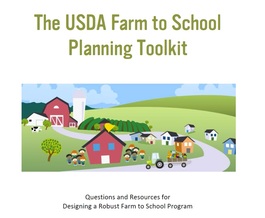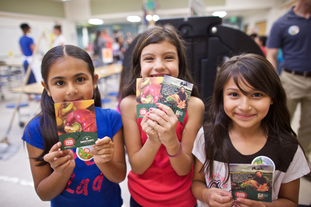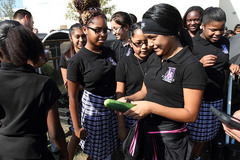Plan for success in 2017
Is farm to school on your resolution radar? If not, it should be! It’s a new year and there are countless ways
to take small steps toward farm to school success in 2017. You might resolve to expand your classroom
library with agriculture-focused books, harvest spring greens from your school
garden and feature them in your salad bar, or make a local farmer a celebrity
by engaging them as a speaker in your cafeteria. No matter where you are on your farm to school
journey, the new year is a great time to reflect on accomplishments and set
goals for the future.
But don’t most resolutions fail?
Here are three tips to make those resolutions stick.
- Start small. You may dream of a district
farm, but starting with classroom container gardens is a great first step.
- Focus on one goal at a time. By focusing on one change at a time, you are
better able to dedicate the time and resources needed to achieve the goal.
- Ask for support. Identify your skills and engage partners who can fill the gaps. Working in a team fosters creativity and
learning, builds trust, and promotes a sense of ownership, which may
contribute to a more sustainable farm to school program.
 Take small steps
Whether you’re just getting started or you're a seasoned farm to school practitioner, the USDA Planning Toolkit can help you reach your
goals. The toolkit includes tips and
examples, insights from others, and lists of resources that can assist schools,
districts, and community partners in:
- Building a Farm to School Team;
- Establishing a Vision & Setting Goals;
- Finding & Buying Local Foods;
- Menu Planning; and,
- much more!
Share your goals & celebrate success
Experts believe that
talking about your goals and celebrating milestones along your journey will
increase the likelihood of long-term success. So share your
#Resolutions2017 with @USDANutrition or email us your
2017 goals at farmtoschool@fns.usda.gov. We will share resolutions and successes
through our e-letter and blog throughout the year!
|

 Local Food Promotion Program supports farm to school
Farm to School Grants aren’t the only USDA grants available
for farm to school efforts. Boulder Valley School District is one of the first
schools in the country to be awarded a Local Food Promotion
Program (LFPP) Grant. LFPP grants support local food business enterprises
in order to increase access to local food and to develop new market
opportunities for farmers and ranchers serving local markets. Boulder Valley
School District received a 2016 LFPP implementation grant for $223,948 over
three years to expand local food promotion and education so increase the school
community’s awareness about local food.
Way to go, Boulder!
|

USDA releases results
of first-ever Local Food Marketing Practices Survey
In late December, USDA published results from the first ever
Local
Food Marketing Practicing Survey. Results show that in 2015, farmers
produced and sold $8.7 billion of local foods directly to consumers, retailers,
institutions, and a variety of local food intermediaries such as food hubs,
distributors and wholesalers that market and sell locally branded products. Of
this total, $3.4 billion, or 39 percent, of all local foods were sold to
institutions such as schools, colleges, universities, and hospitals, and other
local food intermediaries. The survey found that nearly 60,000 farmers and
ranchers sold local foods to institutions and intermediaries. The western
region accounted for the great sales to institutions and intermediaries ($1.2
billion) while the southwest region accounted for the least ($112 million).

 Getting a School Garden Blooming
By Jeff Raska, Texas A&M AgriLife Extension Dallas County Texas
A school vegetable garden can be a wonderful outdoor classroom for
studying natural science. Having worked with school gardens on and off
for more than 25 years, I have seen many great school garden programs
bloom, and then fade as time passes and school priorities change. For
the last seven years, I’ve had the privilege of working with school
gardens as a 4-H Club program assistant for Dallas County and have had
the benefit of seeing a wide range of needs and challenges that schools
face when trying to start a garden. However, the most successful
programs have a few important things in place.
One of the first common elements is a dedicated garden committee. The
committee can include teachers, parents, community members or school
support staff. It’s important to have certain duties assigned to each
member. For example, there needs to be a point person who reaches out
for help when needed and maintains accountability. This is important
because if the garden is funded by outside resources, such as grants or
corporate sponsors, certain benchmarks must be met. I have honestly
tried to talk some schools out of pursuing a school garden because they
didn’t have a committee structure in place. The committee is important
for success.
|

|